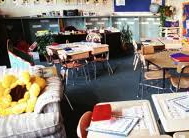This is the second of three posts on the ideal classroom
We strive to answer the question, “What’s worth knowing?” even though we do not know what jobs await our students, or what technologies, or what problems they will face. We take responsibility, to teach tools for lifelong learning as best as we know how.
We build a culture of creativity, a culture of innovation. We resist making academics the sole concentration, and instead build learning around all facets of intellectual and emotional learning. Students have equal access to the arts, humanities, and sciences and understand they have equal value in their learning lexicon.
We allow the work to become evidence for learning. The quality of students’ work reflects the quality of our teaching. We strive to provide authentic performance assessment opportunities. We do not grade students against each other, but instead provide honest, summative assessments of their progress in relationship to clear goals and standards.
We use technology, including smart boards, overheads, VCR/DVDs, computers, cell phones, iPods, and the Internet. Online learning is central, giving students opportunities to use familiar resources in a framework of sensible thinking, reading, writing, discussion, and creative media and arts. We remain open to emerging technologies and their possibilities to enhance learning.
Again, draw a line down the center of a piece of paper. On the left, list which of theses ideals you do in your classroom. On the right, list what you’d like to try.
For more on this crucial issue see Chapter 20 “Imagine the Ideal” in Teaching from the Middle of the Room: Inviting Students to Learn from Amazon: http://www.amazon.com/Teaching-Middle-Room-Frank-Thoms/dp/0615358918.
